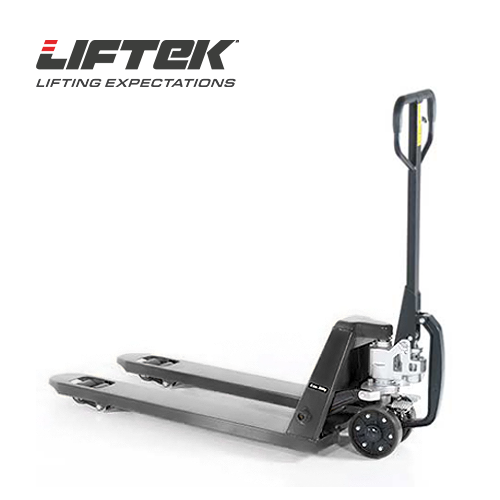Manual pallet trucks are a great tool for any business, but we’re sure you have questions! It is always important to make sure that you get a truck that is best for your warehouse and business, not just what someone else is suggesting. Here at SHS Handling, we’ve taken the time to put together the manual pallet truck FAQs that we get most often from our customers so that you can work out what is best for you. Our team is also here to listen to what you need and suggest the best truck for your needs.
What is a manual pallet truck?
A manual pallet truck, also known as a manual pallet jack, pallet truck or a hand pallet truck, is a material handling device designed for moving palletized loads within a warehouse or a similar environment. It is a simple and cost-effective tool used to lift and transport pallets.
How does a manual pallet truck work?
A manual pallet truck consists of a steel frame with a set of forks that can be inserted under a pallet. The forks are hydraulically operated and can be raised or lowered using a pump handle located on the handle of the truck. By pumping the handle, the hydraulic system raises the forks and lifts the pallet off the ground. The operator then maneuvers the pallet truck by pushing or pulling it to the desired location. To lower the forks and release the pallet, the operator releases the hydraulic pressure by operating a release lever.
What is the weight capacity of a manual pallet truck?
The weight capacity of a manual pallet truck varies depending on the specific model and manufacturer. Generally, manual pallet trucks have weight capacities ranging from around 2,000 to 5,000 pounds (907 to 2,268 kilograms). It is essential to check the load capacity specifications of the particular pallet truck you intend to use to ensure it can handle the weight of your intended loads.
What are the advantages of using a manual pallet truck?
Cost-effective: Manual pallet trucks are generally less expensive than powered alternatives such as forklifts, making them a budget-friendly choice for small-scale operations or occasional use.
Versatility: They can be used in various environments, including warehouses, retail stores, and manufacturing facilities.
Maneuverability: Manual pallet trucks are compact and have a small turning radius, allowing them to navigate tight spaces and narrow aisles with ease.
Ease of use: They have a simple design and are easy to operate, requiring minimal training or expertise.
Maintenance: Manual pallet trucks have fewer moving parts compared to powered equipment, resulting in reduced maintenance requirements and costs.
How do I choose the right manual pallet truck for my needs?
When selecting a manual pallet truck, consider the following factors:
Weight capacity: Determine the maximum weight of the loads you will be handling and choose a pallet truck with a suitable weight capacity.
Fork length and width: Ensure that the fork dimensions can accommodate the size of your pallets.
Wheel type: Consider the type of flooring and surfaces the pallet truck will be used on. Different wheel types, such as nylon or polyurethane, are suitable for specific surfaces.
Ergonomics: Look for features such as adjustable handles or cushioned grips for comfortable operation.
Quality and durability: Choose a reputable brand or manufacturer to ensure the pallet truck is well-built and durable.
Are manual pallet trucks easy to operate?
Yes, manual pallet trucks are generally easy to operate. They have a straightforward design and require minimal training or experience to use effectively. However, it is still important to receive basic training on how to operate a manual pallet truck safely to prevent accidents and injuries.
Can a manual pallet truck be used on uneven surfaces?
Manual pallet trucks are primarily designed for use on flat and even surfaces such as concrete or smooth warehouse floors. While they can handle minor irregularities, they are not suitable for significant uneven surfaces or rough terrain. In such cases, alternative equipment like powered pallet trucks or forklifts may be more appropriate.
What safety precautions should I take when using a manual pallet truck?
To ensure safe operation when using a manual pallet truck, consider the following safety precautions:
- Wear appropriate personal protective equipment, such as safety shoes and gloves.
- Inspect the pallet truck before use, checking for any damage or malfunctioning parts.
- Ensure that the load is properly secured on the pallet and evenly distributed to prevent instability.
- Use caution when approaching ramps, inclines, or declines, as the weight distribution may change and affect the stability of the truck.
- Be aware of your surroundings and watch for obstacles, pedestrians, or other vehicles in the area.
- Do not exceed the weight capacity of the pallet truck to avoid overloading, which can compromise stability and cause accidents.
- When moving the pallet truck, push or pull it smoothly and steadily, avoiding sudden movements or jerks.
- Avoid placing your feet or hands under the forks or between the pallets to prevent injury.
- Use the brake or release lever to securely lock the pallet truck in place when it is not in use or when loading/unloading.
- Do not ride on the pallet truck or allow others to do so.
- If operating on an incline, always move the pallet truck with the forks facing uphill to enhance stability.
- Follow any specific safety guidelines or procedures provided by the manufacturer or your workplace.
It is crucial to receive proper training on the safe operation of manual pallet trucks and adhere to your organization’s safety protocols to minimize the risk of accidents or injuries.
We are ready to chat to you about your business, what you need and how we can help by recommending the best manual pallet truck for your business. Get in touch to chat to our team today.

